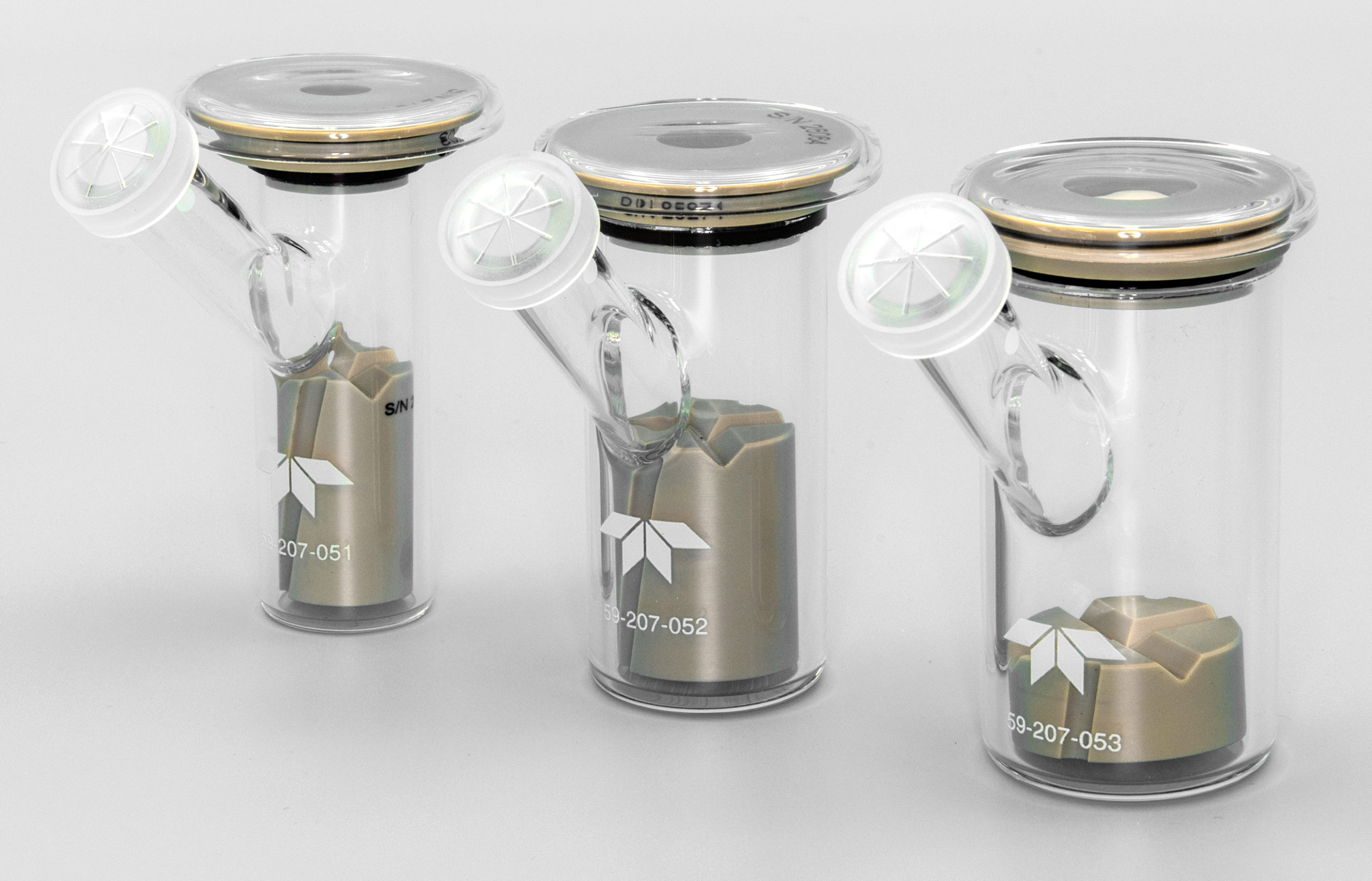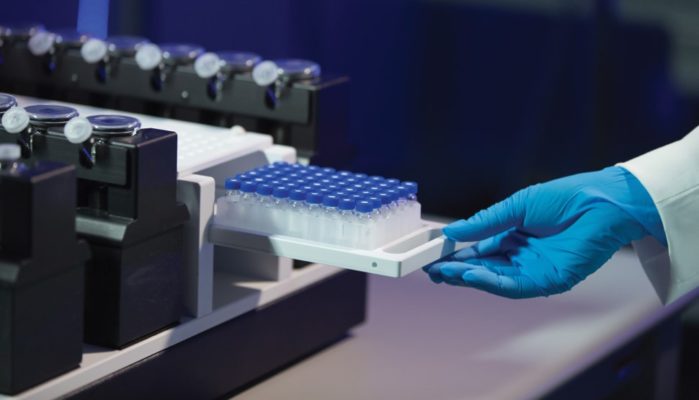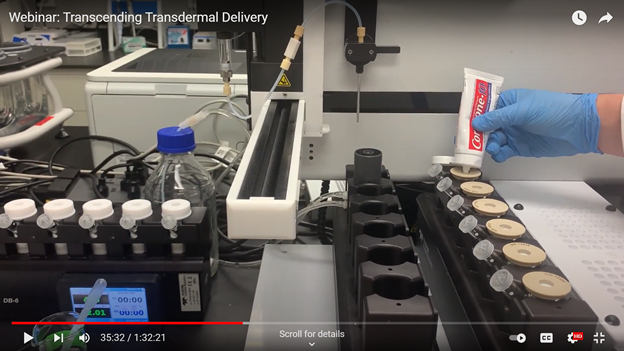
Phoenix Dry Heat Systems
The new Phoenix™ dry heat diffusion testing systems from Teledyne Hanson Research provide manual and automated instruments that are more compact, easier to use, and more precise than conventional systems. The Phoenix family of products includes an advanced cell design, a six‐cell manual sampling system with a compact footprint, and an automated sampling system capable of testing up to 24 diffusion cells at once. The Phoenix DB-6 and Phoenix RDS systems and their components are protected under U.S. patent 10,753,841.
WATCH VIDEO View Phoenix Diffusion Brochure Build Your Own System
PHOENIX™ DRY HEAT DIFFUSION CELLS
The new Phoenix™ Dry Heat Diffusion Cell is designed for precision, versatility, and ease‐of‐use in diffusion‐testing labs. In manual sampling applications, the wide opening in the arm accommodates standard pipette tips. For maximum versatility, lab analysts can choose from small, medium, or large borosilicate glass cells and, using special volume‐adjustment mixer/inserts, can obtain receptor media volumes from 10 mL to 30 mL. An array of cell cap kits accommodates all 25 mm membranes, orifice diameters from 9 mm to 20 mm, and dosage volumes from 0.25 mL to 6.2 mL. A convenient fill mark on the sampling arm indicates the cell is filled. Phoenix cells are easily inserted and removed from the heating block. Cell preparation, including dosage application, bubble detection, and bubble removal, is fast and easy.


PHOENIX DB‐6 MANUAL DIFFUSION SYSTEMS
The Phoenix DB‐6 dry heat diffusion system provides a compact footprint for six‐cell testing. Precision heating and stirring systems contained within the block makes the system fully portable, able to be placed in any position the analyst chooses for faster, easier cell preparation. With precise control of mixing speeds from 200 rpm to 900 rpm, and temperatures from 25 °C to 40 °C, the system meets or exceeds USP <1724> specifications. An advanced color touch screen running on an embedded single‐board computer with a built‐in SQL database and real‐time clock provides advanced monitoring, diagnostic, and reporting capabilities, user‐friendly programming and navigation, storage for up to 100 test protocols, and configurable security for up to 50 users. The large, bright display allows key parameters to be seen from a distance, including speed, temperature, elapsed time, and time to next sample. When sampling is due, the system alerts the operator with the cell position, a countdown timer, and an audible beep. Test reports are delivered via the Teledyne Hanson serial validation printer.
PHOENIX RDS AUTOMATED DIFFUSION TESTING
The Phoenix RDS Robotic Diffusion Station refines the art of diffusion testing by incorporating Teledyne Hanson’s breakthroughs in four areas: diffusion cell design; heating and stirring; automated sampling and collection; and computerized control. The dry heat diffusion cell at the heart of the system delivers significantly improved test results as compared to traditional water‐jacketed, displacement‐sampling systems. The precision heating and stirring components built into each of the six‐cell blocks provide outstanding control of temperature and speed. Automatic sampling and collection are accomplished through a syringe driven probe on an XYZ platform controlled by Teledyne Hanson’s sophisticated Diffusion Master software. The automated system mimics the way sampling, collection, and media replace are performed by laboratory analysts when working manually, while simultaneously reducing the potential for variances due to procedural inconsistencies. The modular design of the six‐cell dry‐heat block allows laboratories to move smoothly between manual and automated methods when scaling to higher numbers of experiments.


Build Your Own Phoenix Diffusion Testing system
The Build Your Own System tool is an interactive way to explore the capabilities of Teledyne Hanson’s diffusion-cell-testing platform known as Phoenix Dry Heat Systems. The configurator will automatically guide you through the steps required to build your own diffusion cell testing system. It will ask you to choose between manual or automated sampling; various cell sizes and mixer-insert combinations to achieve specific receptor media volumes; choices of cell cap kits having different donor chamber volumes and membrane exposed areas (orifice diameters); and so on. It is recommended to first review the configurator instructions. If you have already reviewed the instructions, you can go directly to the “Build Your Own Phoenix Diffusion Testing System” configurator page.
Webinar: In Vitro Bioequivalence Testing of Topical Generic Products: Advances and Challenges in Validated Methods and Regulatory Compliance
Demonstrating bioequivalence of topical products is a challenging task complicated by variations in drug formulations and testing methods, compounded by strict regulatory acceptance criteria. Having an appropriately validated IVRT/IVPT method is mandatory for product development and FDA and EMA approval. In this webinar sponsored by Teledyne Hanson, Theo Kapanadze, D.Sc., Ph.D. (Chemistry), Chief Science Officer of Diteba Laboratories, discusses best practices for the use of IVRT and IVPT methods to obtain bioequivalence waivers for ointments, creams, gels, and ophthalmic formulations.
This challenge can be broken down into more manageable tasks by optimizing the critical factors involved in each stage of the testing process while keeping regulatory requirements firmly in mind.
• New regulatory requirements defined by FDA and European Medicines Agency (EMA)
• FDA bioequivalence testing options and inherent risks, benefits, limitations of each
• Interpreting and applying FDA guidance documents
• Evaluation of in vitro release testing instrumentation, methods, and expected results
• Fundamentals of percutaneous absorption and in vitro permeation testing (IVPT)
• The impact of complete vs. partial receptor-media replacement
• Dealing with unconventional flux profiles


Webinar: Introduction to Ivrt
Evaluating release characteristics of active pharmaceutical ingredient (API) from a semisolid dosage form, whether for product development or quality control purposes, is best accomplished using vertical diffusion cell (VDC) instruments and methods. Obtaining test results that are meaningful for product development and acceptable by regulatory agencies requires a strong understanding of the factors affecting the accuracy and precision of in vitro release testing (IVRT). In this introductory-level webinar moderated by Keith Hamman, Vice President & General Manager of Teledyne Hanson, RaDes GmbH’s Sascha Gorissen, Lab Operations Manager, and Michael Herbig, CEO, will provide details on IVRT methods and best practices to ensure high quality results that fully comply with industry guidance, such as USP <1724> Semisolid Drug Products – Performance Tests.
Topics of discussion
- What is diffusion and how is it calculated?
- Release test (IVRT) vs. permeation test (IVPT)
- IVRT receptor cell media and “back diffusion”
- IVRT test setup: membrane selection
- Determining API release rate
- IVRT method validation: sensitivity, linearity, specificity, and robustness
- Data validation: two-stage comparison testing of reference drug (R) vs. test formulation (T)
Webinar: Transcending Transdermal Delivery
Transdermal drug delivery is very challenging, and numerous strategies have been developed to overcome the skin barrier. This webinar will demonstrate the importance of the formulation on skin delivery, with a strong focus on solubilizers and permeation/penetration enhancers. We will describe the use of Franz cells in a diffusion testing system to assess the formulations with detailed information on the test methods.
Topics of discussion
- Skin barrier and strategies for enhancing drug permeation
- Role of excipients in solubilization, permeation, and skin penetration
- Franz cells diffusion apparatus
- Selecting appropriate membranes: synthetic, animal, or human
- Developing reliable and robust protocols for IVRT or IVPT
- Case studies with model drugs
Speakers
- Dr. Ashvin Patel, Director of Analytical Research & Business Development, Teledyne Hanson
- Elise Dauphin-Chanard, Application Lab Manager, Gattefossé
- Bruna Lousada, European Sales & Marketing Manager, Teledyne Hanson


